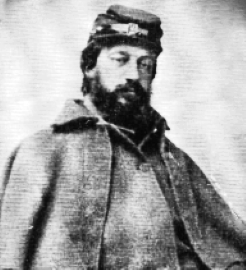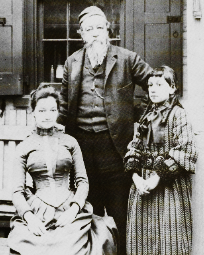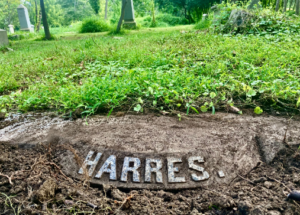Title: Army private, Civil War; druggist, physician
Birthdate: September 12, 1832
Death Date: February 16, 1889
Plot Location: Section 149, Lot 275

Although the surname Harres is not of German origin, that’s the country John’s father, Gebhard, left to settle in Philadelphia and have nine children. John went to Central High School and graduated in 1851. From there he earned a degree from the Philadelphia College of Pharmacy, the nation’s first school of higher learning dedicated to the field of pharmacy.
1860, An Eventful Year
On the 1860 census John was listed as a druggist, single, and living with his parents. His father had been very successful, financially, listing real estate holdings worth $150,000. Their home also included a live-in servant from Ireland. That same year John dropped his single status when he married Mary Jane Durham. It certainly must have caused some controversy at the time because of  her skin color.
her skin color.
She was from a tri-racial group known as the Delaware Moors, a group of interrelated families still found today in central Delaware and southern New Jersey. Their ethnic origins are unclear but they consider themselves neither white nor black. One theory is based on the landing of dark-skinned Spanish pirates mixing with the native Nanticoke and Leni-Lenape tribes. Further mixing with Colonial explorers of European descent may explain why most have English surnames.
1860 was also the year John returned to school. He was a student at Jefferson Medical College, but  only for one year. With the onset of the Civil War, John and other Philadelphians were recruited by Colonel John Kidd Murphy to sign up with the 29th Pennsylvania Volunteer Infantry in 1861.
only for one year. With the onset of the Civil War, John and other Philadelphians were recruited by Colonel John Kidd Murphy to sign up with the 29th Pennsylvania Volunteer Infantry in 1861.
He joined Company F as a private and was in the Battle of Winchester in 1862. Because the 29th was assigned guard duty and not directly involved in the battles at Bull Run and Antietam, they didn’t suffer any casualties. Later that year, however, John lost his sight in his right eye and had to be discharged in January of 1863.
Career & Family
Meanwhile, Mary Jane gave birth to Harry (1862-1915) and Theodore (1863-1894). Gebhard Harres died in 1863 and apparently left large sums to his wife and their four surviving children: John, Theodore, Mary Ann, and Amelia.. When brother Theodore died four years later he left an estate worth $10,000. John must have been just as wealthy, which would explain why he listed his occupation in the 1870 census as “retired druggist.” He also said his real estate holdings were valued at $130,000.
The family resided at 1017 Lombard Street after the war. Three more children were added with the births of Bertha (1869-1954), William (1875-1918), and Margaret (1879-1895) who died of tuberculosis. All three boys became clerks and those were the only jobs they ever had.
In every city directory from 1870 until the year he died, John listed his occupation as a physician. There’s no record of him resuming his education and earning an M.D. but credentials weren’t as important in those days. The 1880 census revealed that the race of every person on the same census page as John was black, and that’s what was recorded (incorrectly) about him.
Limited Eyesight, Greater Vision
This is mere speculation, but it’s possible he chose to specifically serve his neighbors with a “primary care” style of medicine for those who couldn’t otherwise afford to be seen. His pharmaceutical experience would have allowed him to treat the most common ailments that didn’t require specialized care, since he was not fully trained. And since he didn’t need the money, he could afford to charge little, if anything for the limited care he offered.
One source indicated he worked with the first African-American graduates of Jefferson Medical College who eventually started Frederick Douglass Hospital to better serve the city’s black  population. That dream came to fruition in 1895, but John’s heart stopped in 1889 at age 56.
population. That dream came to fruition in 1895, but John’s heart stopped in 1889 at age 56.
Margaret, shown here standing beside John and older sister Bertha, died as a teenager in 1895. Having her buried here beside her father should have been a simple matter, except for the color of her skin.
The Burial Question
Mount Moriah Cemetery made headlines in the 1870s when its Board of Directors declared that “colored people” would not be accepted. The state Supreme Court ruled against them but the widow who won the case chose to bury her husband at Lebanon Cemetery instead.
Under those circumstances, Mary Jane also chose Lebanon for her daughter. It was a privately owned cemetery serving the black community since 1849 at 19th and Snyder Avenue in South Philly. However, Margaret’s was one of the last burials; Lebanon was essentially full, so with no income it fell into disrepair.
In 1899 the city condemned the cemetery and in 1902 relocated the bodies to Eden Cemetery, just to the west of Mount Moriah in Collingdale. That was where Mary Jane was buried in 1904,  followed by every one of her other children. John’s grave at Mount Moriah probably had a nice gravestone with a wall or railing around his plot but all that remains today is this entrance stone.
followed by every one of her other children. John’s grave at Mount Moriah probably had a nice gravestone with a wall or railing around his plot but all that remains today is this entrance stone.
John’s benevolence toward his neighbors and advocacy for healthcare among blacks is impressive for a white man in the late 19th century. He also has a connection to a person of celebrity status. His sister, Amelia Harres Otis, moved with her husband to Atchison, Kansas and had a daughter named Amelia. She grew up to marry Edwin Earhart and also named her daughter Amelia. She was John’s grand-niece who became the record-setting aviation pioneer before she disappeared over the Pacific in 1937.

Support the Friends of Mount Moriah
Help us in our mission to restore and maintain the beautiful Mount Moriah Cemetery by donating to our cause or volunteering at one of our clean-up events.

